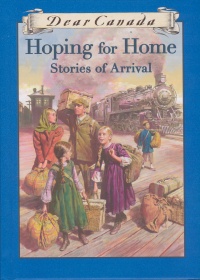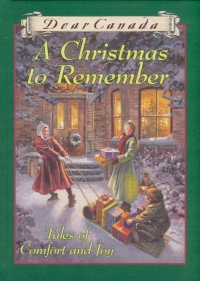| ________________
CM . . .
. Volume XVIII Number 3. . . .September 16, 2011 
 |
Hoping for Home: Stories of Arrival. (Dear Canada).
Lillian Boraks-Nemetz & others. Illustrated by Greg Ruhl.
Toronto, ON: Scholastic Canada, 2011.
242 pp., hardcover, $14.99.
ISBN 978-0-545-98697-7.
Subject Headings:
Immigrant children-Canada-Juvenile fiction.
Immigrants-Canada-Juvenile fiction.
Children’s stories, Canadian (English).
Grades 4-9 / Ages 9-14.
Review by Ruth Latta.
** /4
|
| |
|
 |
A Christmas to Remember: Tales of Comfort and Joy. (Dear Canada).
Jean Little & others.
Toronto, ON: Scholastic Canada, 2009.
241 pp., hardcover, $14.99.
ISBN 978-0-545-99003-5.
Subject Headings:
Canada-History-Juvenile fiction.
Christmas stories, Canadian (English).
Children’s stories, Canadian (English).
Grades 4-9 / Ages 9-14.
Review by Ruth Latta.
** /4
|
| |
|

excerpt:
"[W]hy don't you pledge to write the story of our family from the very beginning, especially what's happened in the last few months?" Bernard suggested. "You could get a beautiful notebook to write in. That way, none of us could ever forget. With that writing talent of yours it certainly would be an asset to the family archives." (From "Out of the Ashes," by Marie Andree Clermont, in Hoping for Home.)
Dear Ben,
About an hour ago, Aunt handed me this little book and told me she wants me to write the story of your first Christmas because you will be too young to remember it. I asked her why she did not write it herself. She said that I was the only one in the family who was a true writer and that she was too busy preparing all the Christmas foods and presents..." (From "Untangling Christmas" by Jean Little, excerpt from the novel If I Die Before I Wake: The Flu Epidemic Diary of Fiona Macgregor, in A Christmas to Remember.)
Algernon: "Do you really keep a diary? I'd give anything to look at it. May I?"
Cecily: "Oh, no. You see, it is simply a very young girl's record of her own thoughts and impressions, and consequently meant for publication. When it appears in volume form I hope you will order a copy." (From Oscar Wilde’s The Importance of Being Ernest.)
In 2001, Scholastic Publishing began its "Dear Canada" series of Canadian historical novels, written in diary form and aimed at pre teen or early teen girls. Each focuses on a young female protagonist living through an interesting time in our nation's history. In one novel, a slave escapes the ante bellum American South to a new life in British North America. Another book has a central character who comes to Canada as a Fille du Roi. Another heroine survives the Halifax Explosion.
Hoping for Home consists of short stories, each an entity in itself. A Christmas to Remember is a collection of Yuletide excerpts from several novels in the "Dear Canada" series. One of my favourite excerpts is "Something that Matters" from Carol Matas' Turned Away: The World War II Diary of Devorah Bernstein, December 6, 1941 to November 5, 1942. This excerpt, set in Winnipeg, captures the way civilians in a country at war are often on tenterhooks, changing focus back and forth from everyday life to the big picture. I liked the way Devorah did a good deed on Christmas, which is not her holiday, by helping a war bereaved neighbour make scrapbooks of her sons's lives. As well, Matas has created a wonderful strong grandmother, Baba, who has a keen interest in international developments and who objects to Devorah’s escaping into Agatha Christie mysteries because "[t]here are real people being murdered every day... and we should pay more attention to the real world."
Series editor Sandra Bogart Johnston writes in her introduction to A Christmas to Remember, "You'll find old friends here, and maybe a new one from a Dear Canada book you haven't read yet". Some of the excerpts, such as Karleen Bradford's "Singing a Prayer" from A Desperate Ride to Freedom, function well as stories while also connecting to the theme of the book from which they were taken. Others suffer from a lack of context. In other excerpts, however, the reader has to stop and figure out who certain characters are, characters who may have been properly introduced in the novels. In one excerpt, a family configuration which may have unfolded gradually in the novel, looks peculiar and complex when summarized for the segment.
One of my favourite stories in Hoping for Home is "The Charleston on the Trapline," by Ruby Slipperjack. In February 1924, Insy, a First Nations girl from Northwestern Ontario, falls seriously ill with a sore throat. Her diary tells how her father took her first by sled, then by rail, to a city hospital. Evocative detail makes readers feel that they are going through her experiences hand in hand with her. Though Insy does not fully realize that many things could have gone wrong on her journey, the reader sees what a perilous expedition it was and how capable and resourceful her father was. Insy is an "unreliable" narrator because of her tender years, like Scout in To Kill a Mockingbird. The author makes good use of the technique of "showing" rather than "telling."
Insy's homecoming is unlike the other stories of arrival in Hoping for Home, a collection in which immigrant/refugee stories predominate. Another outstanding story, Brian Doyle's "Entrance Certificate 1948," does not quite fit the "arrival" theme either, since the central character longs to leave his current circumstances, especially his mother's violent boyfriend. "Penman", the diarist/narrator, is a talented but disadvantaged Grade 8 student stuck in temporary postwar Ottawa housing, and in a school staffed by teachers who are not empathetic. His distinct, individual voice stands out in this funny, yet sad, journal.
Paul Yee's "Prairie Showdown" focuses on a Chinese immigrant whose father brings him to Saskatchewan in 1921 to help him in a cafe. Yee overcomes the limitations of the diary form, presenting vivid descriptions of the region and its people, and the most significant annual event, the harvest. Racist violence is dramatically presented. Instead of having a happy ending, the young narrator experiences an epiphany.
Epistolary novels (novels consisting of imaginary diary entries and letters) appeal to authors for good reasons. Because genuine diaries/letters of actual people exist and often provide a fascinating historical resource, a simulated epistolary work has an aura of authenticity and worth. The confiding nature of first person also makes the story feel real. Also, there's a certain guilty thrill in reading seemingly private thoughts not intended for our eyes.
In an epistolary novel, the author has many pages to establish the voice and nature of the narrator/central character. In a short story, however, the author must quickly present a distinct, unique protagonist. In an anthology of stories in diary form, there is a danger that the narrators may blur, especially when the plots have similar themes (alienation, culture shock, bullying and racism). Rather than reading the anthologies straight through, readers might want to take an intermission after each story.
Because the diary form encourages reportage and narration over dramatization (telling over showing), it takes a truly talented author to create vivid scenes and to build tension. The journal form also encourages amorphous, episodic fictions. As well, the back story (the recital of past events) tends to overwhelm the present action and slow the pace. Another hazard: writers may be tempted to dump history summaries into diary entries rather than to dramatize pivotal events of the past.
Just as a poet chooses a form to suit her inspiration a sonnet, a villanelle, a ballad, free verse so an author lets a short story unfold in the way it wants to be told. Some of the short fictions in these anthologies might have had more colour and impact if structured differently. Today's young readers, the writers of tomorrow, need to see that stories can be presented in many different ways.
Recommended.
Ruth Latta used first person narrators, but not the diary form, for some of the stories in her three collections: A Wild Streak, Save the Last Dance for Me, and Winter Moon.

To comment
on this title or this review, send mail to cm@umanitoba.ca.
Copyright © the Manitoba Library Association. Reproduction for personal
use is permitted only if this copyright notice is maintained. Any
other reproduction is prohibited without permission.
NEXT REVIEW |
TABLE OF CONTENTS FOR THIS ISSUE
- September 16, 2011.
AUTHORS |
TITLES |
MEDIA REVIEWS |
PROFILES |
BACK ISSUES |
SEARCH |
CMARCHIVE |
HOME |

